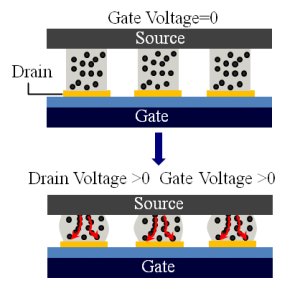Applications of Piezoresistive Nanocomposites in Electronics
- Category: MEMS & BioMEMS
- Tags: farnaz niroui, jeffrey lang, vladimir bulovic
Polymer materials doped with conductive particles exhibit piezoresistive properties. These materials are fabricated such that their conductivity changes with an applied compressive force. When compressed, the formation of percolation pathways allows increased electrical conduction through tunneling between the particles. This work explores and utilizes this property of composites to fabricate various devices with the ultimate goal of developing integrated flexible systems resembling sensory skins.
As a first generation of piezoresistive devices, a squeezable switch (squitch) is fabricated with a three-terminal configuration shown in Figure 1 [1] . In this study, the squitch is fabricated from a composite of polydimethylsiloxane doped with 60 wt% Ni microparticles that shows more than 5 orders of magnitude change in conductivity over a 20% strain (Figure 2). In the absence of an applied gate bias, the composite is a poor conductor. An applied gate voltage generates an electrostatic force between the source and the gate that compresses the composite, causing the squitch to conduct. To allow fabrication of reliable and reproducible devices, the composite needs to be engineered such that its mechanical properties are more stable. To achieve this goal, current research explores the effects of the type of polymer and conductive particles and the method of fabrication on the properties of the nanocomposite and performance of the squitch. The surfaces of the metal particles are chemically treated to allow better distribution in the polymer matrix while also chemically binding the particles to the polymer preventing particle migration over repeated use of the device. After the composite is optimized, future work will involve extending the squitch design to fabricate devices such as analog amplifiers, digital inverters, and various sensors and developing processes to allow large-area fabrication. The devices will then be integrated to develop artificial skins.
- Figure 1: Operation mechanism of the squitch.
- Figure 2: Resistance change in Ni-PDMS composite due to an applied compressive force.
- S. Paydavosi, F. Yaul, A. Wang, F. Niroui, V. Bulovic, J. H. Lang, “MEMS switches employing active metal-polymer nanocomposites,” in IEEE MEMS International Conference, 2012, pp. 180-183. [↩]

